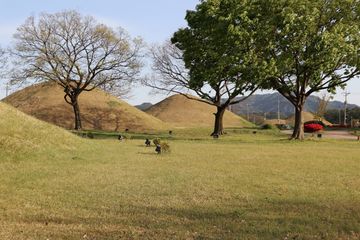경주 대릉원 일원-쪽샘지구
| 쪽샘지구 Jjoksaem District |
|
 쪽샘지구(경주 대릉원 일원), 국가문화유산포털, 문화재청. |
|
| 대표명칭 | 쪽샘지구 |
|---|---|
| 영문명칭 | Jjoksaem District |
| 주소 | 경상북도 경주시 황오동 태종로 788 |
|
|
|
해설문
국문
쪽샘지구는 월성 북편의 원화로, 계림로, 태종로 사이의 구역으로 황남동, 황오동, 인왕동에 걸쳐 있다. 경주역사문화도시 조성사업의 일환으로 고분공원 조성을 위해 국립경주문화재연구소가 2007년부터 발굴조사를 진행하고 있다.
조사과정에서 일제강점기에 확인된 고분 외에도 덧널무덤[목곽묘, 木槨墓]이나 돌무지덧널무덤[적석목곽분, 積石木槨墳] 등 신라 고분이 200여기 이상이 확인되었다. 이들 고분 가운데 일부는 정밀 발굴하여 성격을 밝히고, 나머지는 조사된 둘레돌 등의 자료를 토대로 봉분을 복원하여 신라시대의 고분 분포상을 재현한 고분공원을 조성하고 있다.
철갑옷을 입고 철갑의 말갑옷을 입힌 말을 탄 기마무사(騎馬武士)의 무덤인 C10호와 5세기대 귀족의 무덤으로 보이는 41호 돌덧널무덤 등이 있다. 특히 44호분은 대릉원 일원의 왕이나 왕족무덤과 같이 지상에 축조한 돌무지덧널무덤으로 발굴을 공개로 진행하고 있어 신라 고분문화를 이해할 수 있는 교육의 장으로 많은 사람들이 찾고 있다.
영문
Jjoksaem Archaeological Site
The Jjoksaem District is part of the Daereungwon Ancient Tomb Complex and is located to the east of the Daereungwon Historic Park. They are presumed to date to the Three Kingdoms period (57 BCE-668 CE) and belong to the aristocracy of the Silla kingdom (57 BCE-935 CE).
The tombs in this area were first identified during the Japanese colonial period (1910-1945), and in order to develop the area into an ancient tomb park, the area has been undergoing archaeological excavations since 2007.
The tombs excavated here are wooden chamber tombs or wooden chamber tombs with stone mounds. Only some of the tombs were excavated thoroughly. The earthen mounds of the rest were rebuilt based on a survey of materials such as mound-base stones so that the area can be made into a park that shows the distribution of ancient Silla tombs.
Some noteworthy tombs include Tomb No. C-10, which belonged to a cavalryman wearing metal armor and riding a horse wearing metal armor, and Tomb No. 41 which was a stone-lined tomb presumed to date to the 5th century and belong to an aristocrat. The excavation of Tomb No. 44, an above-ground wooden chamber tomb with stone mound, has been made viewable to the public to aid in the education of Silla’s tomb culture.
- The name Jjoksaem means “Small (Gourd) Spring,” and was the name of the village that once stood here. It said there was a well in the village with clean and delicious water that never ran dry, and the villagers often drank the water with a small gourd.